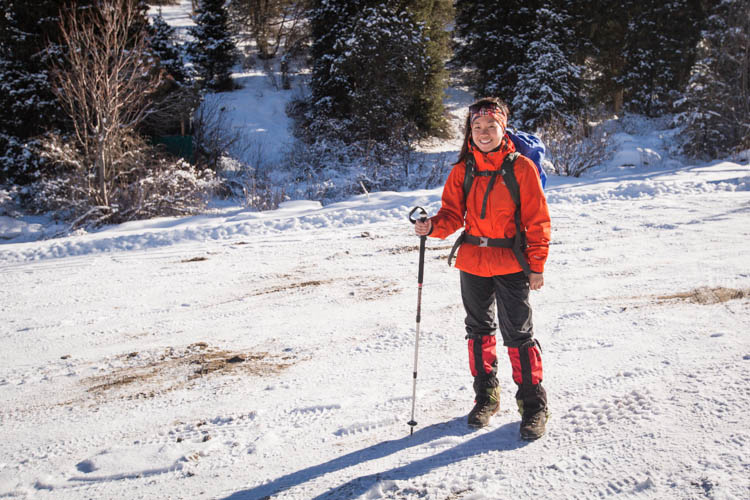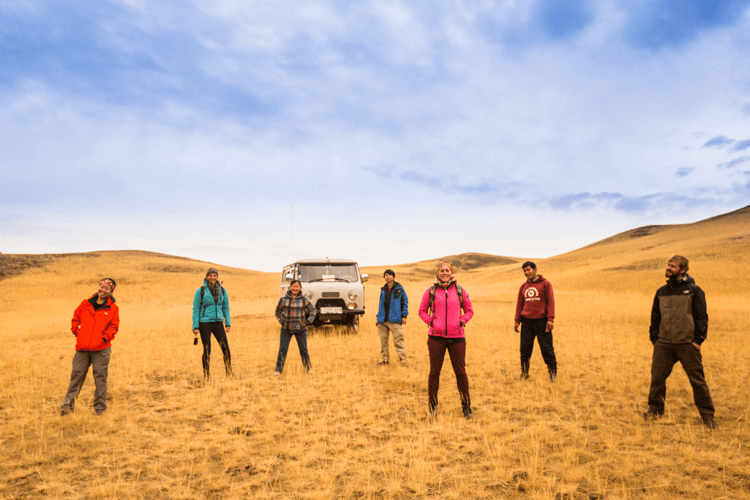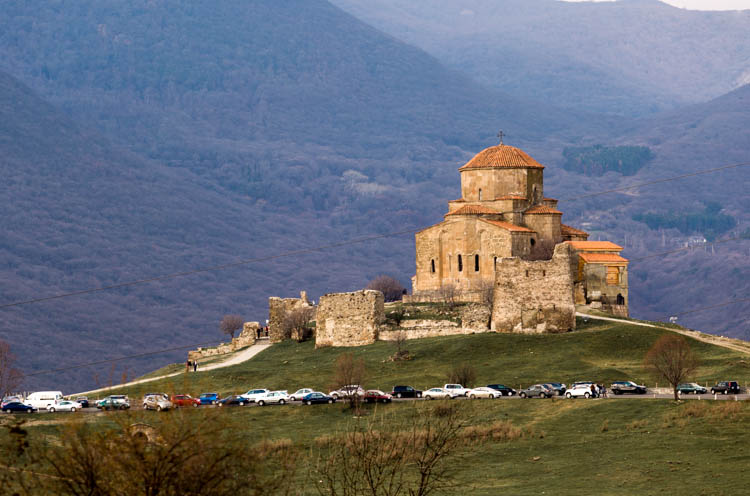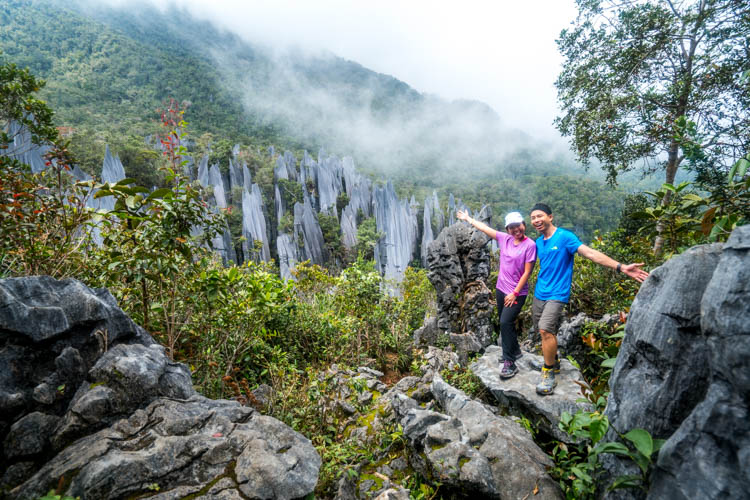We’ve hiked quite extensively previously but it was mostly done during summer or autumn. This was our first time hiking in winter and it was definitely an eye opener for us. We did a simple 1 day hike at Kegeti Gorge and more challenging hikes at Ala-Archa and Altyn Arashan in Kyrgzstan. From these hikes, we’ve learnt so many useful tips and we thought it might be beneficial to you guys too! You never know when it’ll be your turn to hike in winter. Always better to be over prepared than under prepared 😉
Proper attire and gear to keep warm and dry
Waterproof alpine shoes – It’s no joke hiking on snow and definitely not funny when snow gets into your boots! Your toes will freeze in minutes and eventually you won’t feel your toes at all (okay, slight exaggeration, but frost bite is really not something that you’ll want during your hike!). Alpine boots are completely waterproof and usually high cut. This will help reduce the chances of snow getting into your shoes.
Gaiters – This was our first time coming across gaiters. It might look like an added decoration to your outfit, but it’s actually very practical! Gaiters are a type of waterproof synthetic garment that you wear on the outside of your lower pants and boots. Besides it making you look more professional, it also further prevents snow from entering your shoes and adds extra warmth to your legs!
Waterproof clothing – Ideally your outermost jacket and pants should be waterproof when hiking on snow. Should you slip and fall (very likely) or even snow while you’re hiking, at least your clothes will not absorb any additional water. Also, don’t forget your waterproof gloves! Thank god I had those, I lost count of the number of times I slipped and my hands dived straight into the snow. My fingers would have been gone by now if I didn’t have those gloves on!
Thermal wear – Learn to regulate your body temperature properly. Wear just enough to not sweat too much when you’re hiking. You don’t want to end up as a frozen popsicle! I made the same mistake again of wearing too many layers and after an hour of hiking, my entire back was drenched with sweat! Best option is to practice layering. That way you’ll be able to remove or add more layers when necessary. If you’re staying overnight at the mountains, a down jacket is essential. Temperatures during the night fall drastically and you need all the warmth that you can get.
Hiking more effectively

Angle your feet at almost 90 degrees instead of pointing it forward when treading uphill on loose snow. This will help reduce the chances of your foot slipping backwards, It definitely worked, but the con is that my ankles hurt after all the twisting and turning of the feet.
Never go on an unguided tour during winter unless you’re an expert in that region. Or perhaps maybe it’s also possible to hike without a guide during summer when the path is more visible and obvious (but of course, you’ll need to have some experience in hiking first). During winter, it’s a whole different ball game! Everything is covered with snow and if you’re not familiar with the hiking route, it’s impossible to know which way to go. The snow also disguises the uneven rock surface and you might not know if it’s safe to step on. But with a guide, he will clear the path for you and ensure it’s safe before you continue.
Estimate your time properly. Start off your hike earlier during winter as the day is much shorter as compared to summer. Hiking uphill is much harder during winter and you might end up taking double the time needed as compared to during summer. We underestimated the time needed for our hike at Ala-Archa and started our hike only around noon. By the time we were at our half way mark, the sun was already setting and it was almost impossible to finish the hike 🙁 If we had started our hike at say 7am, perhaps we might have made it to the hut. You can read more details about our arduous hiking experience at Ala-Archa here.
Understand your body. When you feel pain in your toes or fingers due to the cold, it is still a good sign. But once you don’t feel anything at all in your toes or fingers and they’re turning blue, this is a telltale sign that you might be having frost bite! When you’re climbing uphill, you’ll feel your muscles working harder and becoming more tensed, which will reduce the blood flow to your feet. That’s when you should slow down, do some simple leg exercises by swinging your leg front and back to its maximum for about 10 minutes to increase blood flow to your legs. Drink some hot liquids and get as much warmth as you can. The last thing you want is to lose any of your fingers or toes! When going downhill, your muscles are more relaxed and you shouldn’t feel any numbness or pain in your feet as the blood flow is more regular.
Essential items that you should bring

Water bottle or even better, a thermos flask. Forget about your water bag. I know, I did mention in my other posts about how useful a water bag is for hiking. But when hiking in sub zero temperatures, the water at the opening will freeze and makes it impossible to drink any water from it! If you have a thermos flask, fill it with some hot sweet flavoured tea of your choice. Misha offered us his hot tea when we had our break and it was so soothing to drink it in such a cold weather!
Bring about 500ml or 1L of drinking water as recommended by our guide, Misha. He shared that we could actually just boil snow or ice when we’re at the hut and that there’s no need to bring so much water. We stupidly brought 2L of water each which really weighed us down!
Hiking poles – 2 poles are the best. hiking on snow is really a test of your balancing skills. Sometimes when you take a step forward, the snow might cave in and throw you off balance. In such a situation, a hiking pole will save your ankle. Also the poles will be useful in prodding the snow ahead of you to ensure that it’s safe to step on before you take the next step. Besides this, the poles will also reduce the pressure on your knees and ankles.
Sunglasses – With the sunrays shining against the shimmering snow, it’s tough to hike without squinting your eyes. A good pair of shades would certainly be useful in this case. Doubt you’ll want to carry on this hike with your eyes half closed!
Sleeping bag – Choose a good sleeping bag that’s made for sub zero temperatures. Check the label at the side of the sleeping bag which will indicate the comfort level of the sleeping bag. Down bags are the best, but bearing in mind that you have to ensure that they’re kept dry as once the feathers are damp, it will not be able to keep you as warm and might in fact cause you to be even colder!








Leave a Comment